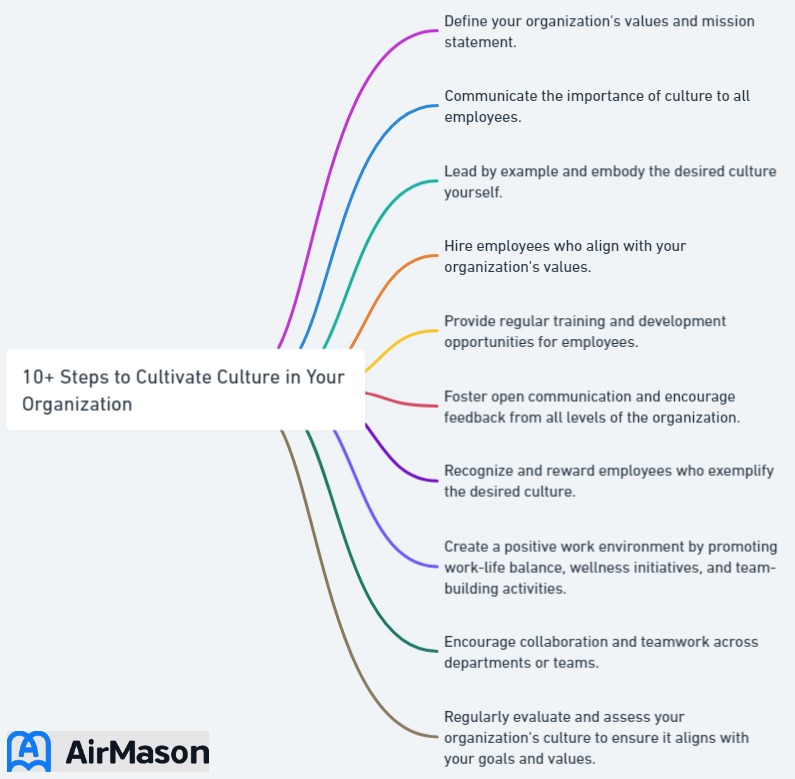
Are you struggling to create a thriving company culture that engages employees and drives productivity? Cultivating a strong organizational culture is more than just buzzwords and team-building exercises; it’s about fostering an environment that nurtures employee growth, innovation, and unity. In this blog post, we’ll explore over 10 actionable steps to help you cultivate culture within your organization, leading to long-term success and employee satisfaction. Are you ready to transform your organization’s culture? Let’s dive in.
Key Takeaways
- Establish a strong mission and vision statement to attract top talent.
- Emphasize core values, build relationships through team-building activities, open communication channels & regular feedback sessions.
- Invest in employee development & prioritize recognition/rewards for an engaged workforce.
Establishing a Strong Mission and Vision
A well-defined mission and vision statement is the foundation of a strong company culture. When employees understand the company’s purpose and direction, they feel a sense of belonging and are more likely to be engaged in their work. Different industries have different definitions of success, but when a company’s mission and vision are clear, employees across various sectors can unite under a common purpose.
Connecting employees with a purpose that resonates with their aspirations is pivotal for them to comprehend the company values. This connection between employees and the company’s goals helps create a strong culture that drives organizational success. Cultivating a culture that attracts and retains top talent is possible through the establishment of a clear mission statement and emphasis on the importance of shared values.

Emphasizing Core Values
Core values are the backbone of any thriving organizational culture; they represent the guiding principles that influence decision-making and behavior. Emphasizing and integrating these core values into daily operations, rather than treating them as mere abstract concept, is crucial in creating a genuine company culture.
Incorporating core values into daily operations can be achieved by:
- Making them part of the decision-making process
- Encouraging employees to adhere to them in their own way
- Rewarding those who demonstrate their commitment
Fostering a culture of recognition and providing employees with the chance to express their values beyond office walls would contribute to emphasizing core values and cultivating a strong, authentic culture.
An Organization’s Culture
An organization’s culture encompasses the shared values, beliefs, and behaviors that define its identity and guide the conduct of its members. It serves as the foundation upon which the entire entity operates, influencing how employees interact, make decisions, and approach challenges. This culture is not a static entity; rather, it evolves over time, shaped by the collective experiences and perspectives of its workforce. An organization’s culture can be overt, with stated mission and value statements, or it can be implicit, embedded in the daily rituals and norms of the workplace. It plays a pivotal role in attracting and retaining talent, as individuals are drawn to environments that align with their own values and aspirations. Ultimately, an organization’s culture is a powerful force that has a profound impact on its success, shaping its reputation, innovation capacity, and ability to adapt in a rapidly changing world.
Enhancing Employee Engagement

Employee engagement is a critical component of a successful organizational culture. In this section, we’ll explore three key areas that can help enhance employee engagement: team-building activities, open communication channels, and regular feedback sessions. Focusing on these areas can aid in creating an environment where employees feel connected, valued, and motivated to contribute to the company’s success.
Team-Building Activities
Organizing team-building activities outside the office is a great way to foster camaraderie and teamwork. These activities can help employees from different industries develop relationships, encourage collaboration, and cultivate a sense of inclusion, leading to better teamwork.
Examples of effective team-building activities include:
- Scavenger Hunts
- Escape Room Challenges
- Rock Climbing
- Trivia Competitions
- Share Resumes
These activities offer a platform for team members to connect, communicate, and work collaboratively towards a common goal, which ensures everyone is engaged and contributing to the organization’s culture.
Open Communication Channels
Encouraging open communication plays a vital role in creating a healthy work culture where employees feel heard and valued. A fertile culture is one that is adaptive to changes and encourages open communication without fear of repercussions.
Implementing technologies such as Google Chat, Slack, Microsoft Teams, and collaborative platforms can help establish open communication channels within your company. These tools provide employees with the means to communicate effectively, collaborate on projects, and stay connected regardless of their physical location, ensuring they understand the company’s goals and values.
Regular Feedback Sessions
Regular feedback sessions are essential for cultivating a culture of continuous improvement within an organization. These sessions help employees understand their performance, pinpoint areas for development, and offer managers the chance to recognize and reward employees, contributing to the desired culture.
The frequency of feedback sessions can vary depending on the organization’s needs and culture. Some experts suggest conducting performance reviews every 6-12 months, while others recommend quarterly reviews. Weekly feedback sessions may also be beneficial for staying updated and ensuring consistent expectations. Ultimately, it’s crucial to find the right balance that works for your organization and keeps employees engaged and informed.
Investing in Employee Development

Investing in employee development is a fundamental component of cultivating culture in an organization. By providing training, mentorship, and performance plans, you demonstrate a commitment to your employees’ growth and success. Training can increase job satisfaction, boost productivity, and improve employee retention across different industries.
Mentorship is another essential aspect of employee development, offering long-term benefits such as enhancing personal and career development, fostering better workplace leaders, and inspiring motivation. Performance plans should be tailored to the individual and periodically reviewed to ensure employees are achieving their goals and contributing to the desired culture.
Fostering a Positive Work Environment
Creating a positive work environment is crucial for establishing a strong organizational culture. Fostering respect, inclusivity, and a relaxed atmosphere in the workplace can contribute to increased employee engagement and overall productivity.
Fostering enthusiasm and ensuring your employees feel valued and engaged can be achieved by:
- Sharing useful articles and motivational inspirations
- Nurturing internal relationships to construct a robust work culture
- Boosting employee engagement and cultivating a sense of respect and camaraderie
- Contributing to long-term success
Positive Work Environment
A positive work environment is essential for fostering productivity, creativity, and employee satisfaction. It encompasses a range of factors that contribute to a harmonious and fulfilling workplace. One of the key elements of a positive work environment is open communication, where team members feel comfortable expressing their ideas and concerns. This transparent dialogue cultivates trust and builds strong working relationships among colleagues. Additionally, a supportive and inclusive atmosphere, where every individual feels valued and respected, plays a pivotal role in creating a positive work environment. When employees feel acknowledged for their contributions, it boosts their morale and motivation, leading to higher levels of engagement and performance.
Encouraging Collaboration and Teamwork
Fostering collaboration and teamwork can lead to heightened feelings of connection and involvement among employees, resulting in improved productivity and creativity. Recognizing small successes on a regular basis can help foster a robust organizational culture by increasing morale and providing a sense of achievement, making sure employees feel valued and motivated.
Goal alignment can also improve employee engagement by:
- Increasing transparency and enabling employees to comprehend how their efforts contribute to the company’s goals as a whole
- Creating an environment where employees feel connected and engaged
- Leading to increased productivity and innovation
- Encouraging collaboration and teamwork
Prioritizing Recognition and Rewards

Recognizing and rewarding employees for their accomplishments is essential for cultivating a strong company culture. Studies have shown that making recognition a fundamental part of work culture increases the likelihood of having a highly engaged workforce by four times.
Implementing a variety of reward systems that align with your company culture and values is crucial for motivating and engaging employees. Consider involving employees in the process to ensure rewards are meaningful and motivating.
Prioritizing recognition and rewards can boost morale and reinforce the company’s values, fostering a stronger, more cohesive organizational culture.
Building Trust and Transparency
Trust and transparency are critical components of a healthy organizational culture. Creating an environment where trust and transparency thrive can be achieved by fostering open communication, sharing company information, and treating employees fairly.
Building trust among employees and leadership is essential for creating a positive work environment, which in turn encourages productivity and contributes to long-term success. Integrity at the executive level is also crucial, as its absence could have a detrimental impact on the organization’s culture. Laying the foundation for a healthy and successful organizational culture requires a focus on building trust and transparency.
Aligning Company Goals with Employee Aspirations

Aligning the company’s goals with employee aspirations is a key factor in cultivating a strong culture within your organization. When employees understand how their efforts contribute to the company’s culture and goals, they are more likely to be motivated and engaged in their work.
Providing employees with clearly defined objectives and outlining their professional growth path within the organization can make sure that they are aligned with the company’s goals. Maintaining high standards and focusing on employee growth can create an environment where everyone is working towards a common objective, fostering a sense of unity and purpose.
Implementing Effective Hiring Practices
Recruiting for cultural fit and shared values offers numerous advantages, such as increased employee job satisfaction, higher retention rates, improved collaboration and productivity, and amplified performance. Implementing effective hiring practices can foster team cohesion, improve communication and collaboration, and lead to higher job satisfaction and employee retention.
Focusing on cultural fit and shared values during the hiring process can help create a cohesive and successful team that contributes to a strong company culture. This approach not only benefits your organization in the short term but also sets the foundation for long-term success and growth.
The Dynamics of the Corporate World
The corporate world, characterized by its intricate web of businesses, organizations, and enterprises, constitutes the heartbeat of global commerce and industry. In this highly competitive arena, companies strive for market dominance, innovation, and profitability, often navigating a complex landscape of regulations, partnerships, and consumer demands. The corporate world is a dynamic ecosystem, where strategies are devised, mergers negotiated, and technologies harnessed to gain a competitive edge. It is a realm where leadership, teamwork, and adaptability are paramount, and where the ability to foresee and respond to market trends can mean the difference between success and stagnation. Within this realm, businesses must also grapple with ethical dilemmas and questions of social responsibility, recognizing that their actions bear weight not only on their bottom line, but also on the broader communities and environments in which they operate. As such, understanding the intricacies of the corporate world is crucial for anyone seeking to thrive in today’s global economy.
Summary
In conclusion, cultivating a strong organizational culture is a multifaceted process that requires a focus on various aspects, including establishing a clear mission and vision, emphasizing core values, enhancing employee engagement, and prioritizing recognition and rewards. By implementing the strategies and steps discussed in this blog post, you can create a thriving company culture that engages employees, drives productivity, and leads to long-term success.
Remember, a vibrant organizational culture is more than just a collection of policies and procedures; it’s about creating an environment where employees feel valued, connected, and empowered to contribute to the company’s success. By investing in your employees and nurturing a strong culture, you can lay the foundation for a prosperous future that benefits both your organization and its people.
Frequently Asked Questions
What does cultivate a culture mean?
Cultivating a culture means taking collective responsibility to grow and learn together in order to maximize impact as a group.
Who is Austin Belcak?
Austin Belcak is the founder of Cultivated Culture, an organization teaching people how to land their dream jobs without relying on traditional methods or online applications.
How to compare JD with resume?
Comparing a job description to your resume is a simple process. Start by creating a template or core resume, and scan the job description for keywords that match your skills. Incorporate those keywords throughout your resume to ensure maximum relevancy for the position.
How can I get my resume worded for free?
Take advantage of the comprehensive free resume reviews from Resume Worded, Jobscan, TopResume, ZipJob, Hiration, Ladders, Monster and EnhanCV. Make sure to use a professional tone and ensure that your resume does not contain any artifacts or irrelevant introductions or summaries.
What is the importance of having a clear mission and vision for fostering a strong company culture?
Having a clear mission and vision statement encourages employees to feel a sense of belonging, leading to an engaged workforce and strong company culture.